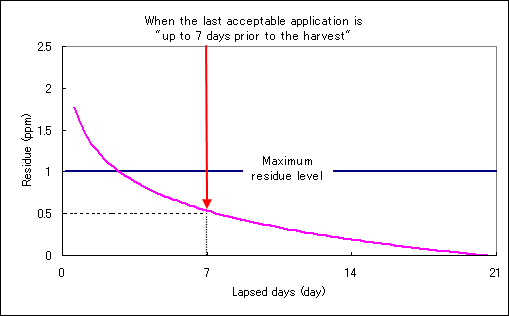Basic Knowlegde of Agricultural Chemicals
6. Compliance with the approved use
The maximum residue level of an agricultural chemical is established for each crop, as a residual dose that can be safely ingested without appreciable health risk to the consumer. This is based on the assumption that usage directions (e.g., period, concentration, and frequency of use) are followed not to exceed the level. These directions can be found on the label of the agricultural product.
Since this maximum residue level allows a generous safety margin, and in the actual setting, people wash or peel the agricultural products before eating, significantly less amount of the agricultural chemical is ingested than had been analyzed without washing and peeling. Sufficiently high safety is guaranteed by following the usage directions on the label, not exceeding the specified limit, along with such a generous safety margin.
We take an example in which the maximum residue level of an agricultural chemical A in crop B is set at 1 ppm. Assuming that when agricultural chemical A is applied to crop B, and that the maximum residue level in crop B decreases as shown in Fig. 8, the residue of 2 ppm immediately after spraying drops to 0.5 ppm 7 days later. Thus the last acceptable spray day can be set as "up to 7 days prior to the harvest". The residue on crop B cannot exceed the standard values if the users apply agricultural chemical A observing this usage period.
Furthermore, it is critical to prevent residue in drinking water and harm to aquatic organisms caused by agricultural chemicals, as well as the residue in crops. It is users' responsibility to follow usage directions, including compliance with the static period, if applicable.

Figure 8. Decreasing curve of the residual agricultural chemicals
To guarantee the above mentioned safety, the Standards for Agricultural Chemical Use has been established by the Ministers of Agriculture, Forestry and Fisheries, and the Environment, on the basis of the Agricultural Chemicals Regulation Law, thus users of agricultural chemicals are legally obliged to comply with these standards.

